Having argued last week (see here) that the Scottish Government could lift the shutdown of self-catering accommodation and its advice not to travel further than 5 miles, its announcement on Wednesday (see here) that this would now happen on 3rd July was a step in the right direction. Neither restriction has been necessary for weeks now. The risks of transmitting Covid-19 outdoors or in self-catering accommodation are both very low and there has been no scientific rationale for these restrictions since the first few weeks of the lockdown.
If the opening of the much higher risk indoor venues which is due to start just a week later, from 10th July, results in further outbreaks of Covid-19, it is very important that the unjustifiable restrictions on outdoor recreation and travel are not re-introduced. Any future lockdowns need to be far more proportionate and targeted at preventing people gathering indoors and close together in groups outside.
The issue that now needs to be addressed is that the number of people wanting to visit Scotland’s countryside over the summer is likely to be higher than ever before. Unfortunately government appears completely unprepared and no body more so than the Loch Lomond and Trossachs National Park Authority. This post takes a look at what is likely to happen over the next few weeks and what needs to be done.
The likely surge in visitors to Scotland’s countryside
Thursday saw the start of the school holidays in Glasgow. Normally thousands of families would be heading abroad before the English school holidays start. They have nowhere to go. Glasgow’s parks were heaving until the rain today. Already many families have decided to ignore Scottish Government advice not to travel more than five miles and decided to head out into the countryside for the day. On 3rd July more families and people who are still observing the Scottish Government’s advice not to travel ,will also start to go out to the countryside. Unless the weather intervenes, this will result in a higher number of day visits to the countryside than ever before.
Most people also want some sort of holiday and, if flights abroad don’t re-start (as seems likely), families who are constrained by school holidays in ways that other people aren’t, will be likely to take them in Scotland.
The potential demand will be affected by a number of factors but can be estimated from past data. The most recent tourism statistics (see here) show that in Scotland in 2018 there were around 16 million overnight visitors, who stayed for 65.4 million nights, and a further 153 million day trips. Most of these visitors are from Scotland and the UK. Unsurprisingly, the relative spend of international tourists (who are more likely to do expensive things like stay in Edinburgh or go deer stalking), is greater:
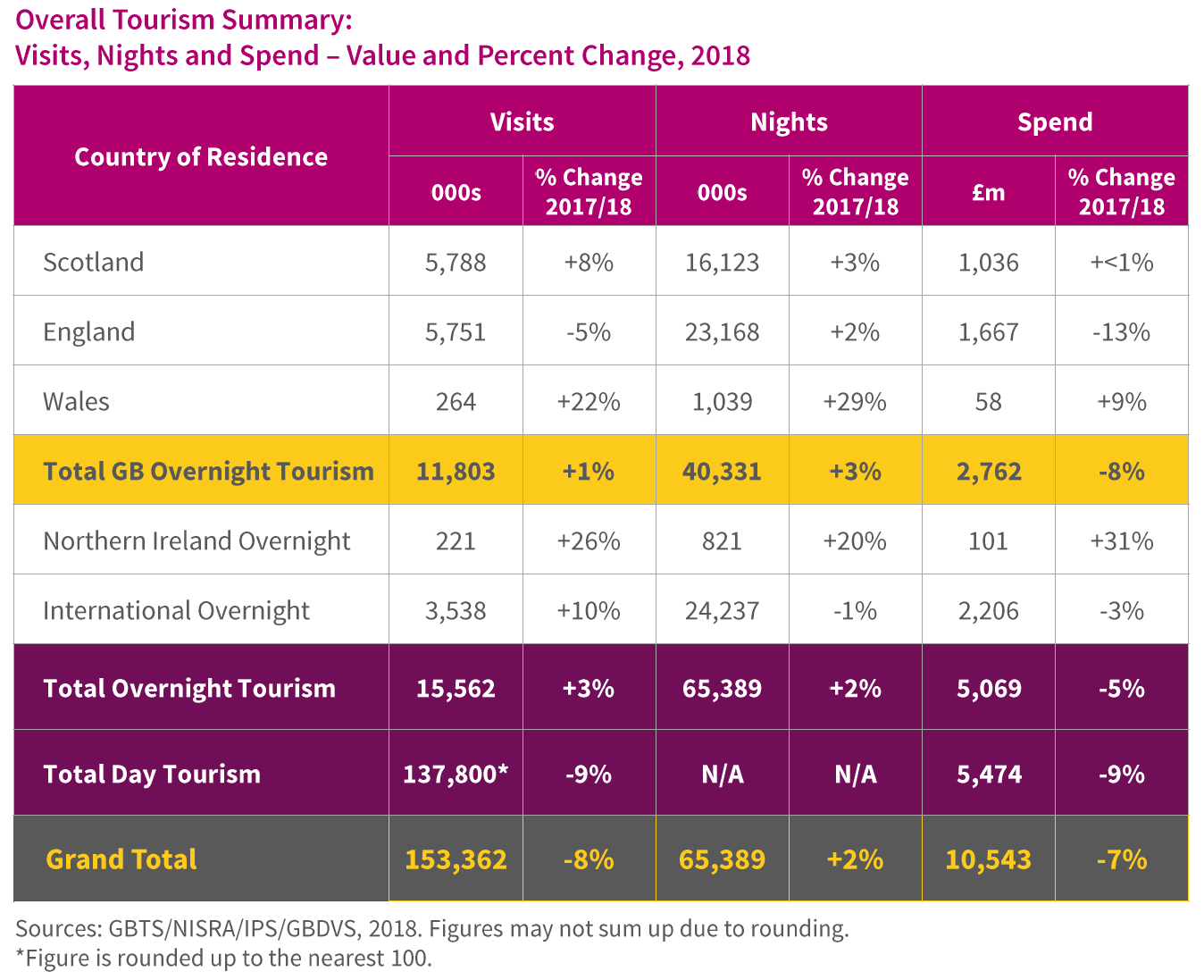
Across the UK there are 72.6m trips abroad at an average 9.8 nights each year. If apportioned by Scotland’s share of the UK population, 8.2%, that makes just under 6 million trips abroad or c55 million nights away. If even half of those people were now as a result of Covid-19 to decide to holiday in Scotland, the number of domestic overnight stays would almost treble. Add a similar increase in demand from the rest of the UK and it’s obvious that increased “staycations” will vastly outnumber the loss of visitors from abroad.
This potential increase in demand could be slightly offset by fear, a reluctance from some people to leave home. This was recorded in the most recent visitor market surveys from early June (see here):

Yesterday, however, booking agencies recorded their highest number of bookings for self-catering accommodation ever. This turnaround may be linked to the finding in the surveys which showed that people felt far more confident about taking holidays if they involved being outdoors:
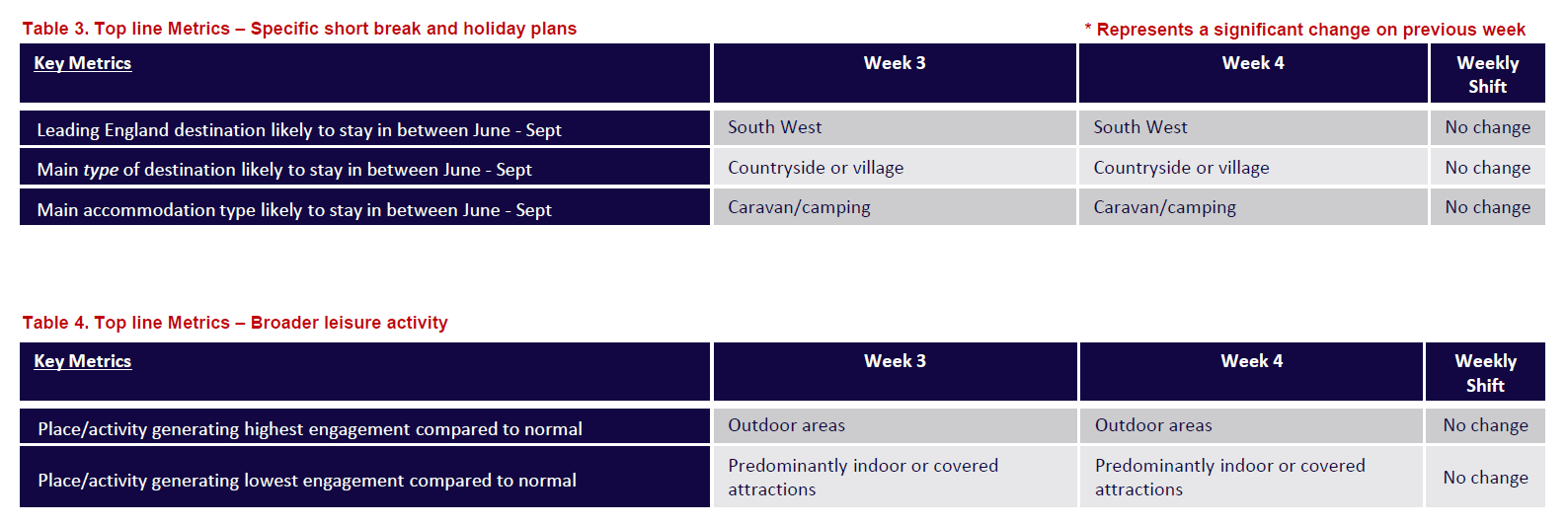
People know outdoors is safer and are making plans based on that. The implications are that people are far more likely to want to visit the countryside than the towns and, just as importantly, more people will want to stay outside, camping and campervanning. What appears to have changed in the last month is that people now realise that self-catering, because it is self-contained, is also safe. Whether bookings in hotels, which employ far more people, picks up remains to be seen.
The demand for camping is likely to be increased further because of the economic hardship caused by the coronavirus. For many people camping will be the only affordable option.
If the numbers of Covid-19 cases continue to drop, attitudes may change further, but at present the surveys confirm that the UK tour industry, with older people coached from hotel to hotel and attraction to attraction, is unlikely to get going anytime soon and any recovery will be based on the great outdoors. This has massive implications for the tourism industry but also for the management of the countryside.
The likely impact of this surge to the countryside
At present many car parks and toilets in the places that people are most likely to go for day trips remain closed. The problem is particularly acute in the Loch Lomond and Trossachs National Park where all National Park toilets and car parks remain officially closed and where Stirling Council has renewed its closure of the Rowardennan and Bracklinn Falls roads until Thursday 16th July. This concentrates people in even fewer places without appropriate facilities.
Even where a car park has been opened, capacity is insufficient:

The number of people at Ben A’an is likely to have been increased due to the closure of the car park at Balmaha and the road to Rowardennan.

Social media forums are awash at present with questions from people asking where to go and good places to try out hill walking for the first time. The suggestions that tend to come back involve places Conic Hill, Ben Venue, Ben A’an and Tinto. With access to Conic Hill almost impossible, it’s not surprising that pressure has increased even further at places like Ben A An.
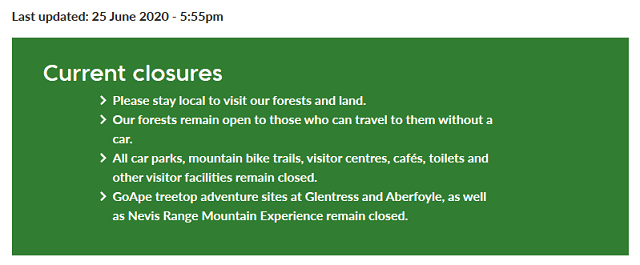
Unsurprisingly, the three big issues are the same as they have been since the creation of the National Park, parking, toileting and litter and these issues are creating concerns in local communities and an element of backlash. Thankfully, some organisations have now written to the Scottish Government about the impending disaster:
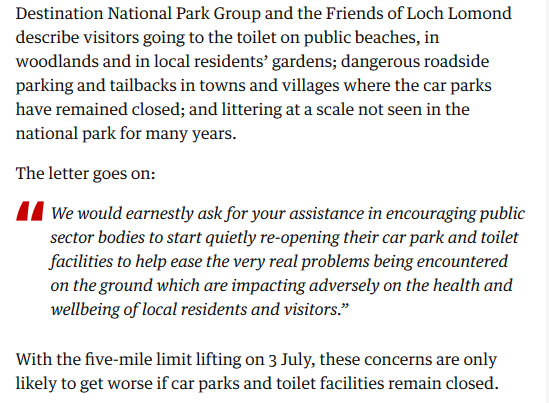
Unfortunately it appears that the LLTNPA, which lost all capacity to act independently of the Scottish Government years ago, will not do anything to prevent these issues until given the go-ahead by Scottish Ministers. If Scottish Ministers wanted to be helpful, therefore, the best thing they could do is tell public authorities that they should start re-opening car park and toilets now.
There is now very little time to prepare for the 3rd July when the number of people wanting to visit the countryside is likely to be higher than ever before. At the online LLTNPA Board meeting ten days ago there were a couple of references to the possibility of increased demand but no consideration of how great this might be or what might need to be done to meet this. No-one suggested estimating the total costs and approaching the Scottish Government for help.
Previous research would have provided a good starting point for discussion:
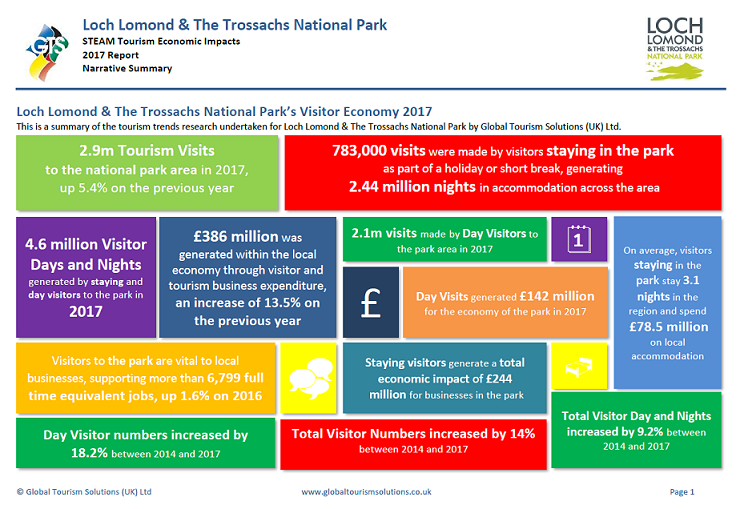
So what happens if the number of day visitors and overnight visitors in the National Park double, from 4.6 million to 9.2 million days and nights, with most of this concentrated in the next few months? And what happens if within this, as seems likely, the demand for camping and campervanning trebles?
Shortcomings in current capacity
Over the past four years I have blogged on numerous occasions (some links below) about the deficiency in visitor infrastructure in the Loch Lomond and Trossachs National Park and the systematic failure of the LLTNPA to address the issues. Grossly inadequate provision of visitor infrastructure is now going to come home to roost (and will be replicated to varying extents across Scotland):.
- Insufficient public toilets across the National Park (see here). The lack of capacity shortages will be made worse by the need to close the toilets frequently to allow regular cleaning.
- The lack of chemical disposal points for campervans (see here) . There is just one public disposal point at Tarbet
- Absence of litter bins in large parts of the National Park and lack of staff to clear up litter where it does occur (see here). People are less likely to litter in places that are kept litter-free
- Absence of mechanisms to manage high levels of traffic, e.g on east Loch Lomond, and chaotic regimes for car parking, with a charging free for all (see here). Traffic will be made worse because of the limitations on anyone using public transport at present even where it does exist.
- Lack of campsites and inappropriate and insufficient camping permit areas within the camping management zones (see here). The shortage of places will be made worse by the requirement to put physical distancing measures in place.Parking chaos
Even if ALL current capacity is re-opened by the 3rd July, it will be insufficient to cope. That, however, is not going to happen because the upgrade work for the toilets at Firkin Point and Balmaha was suspended during the lock down and they remain out of commission.
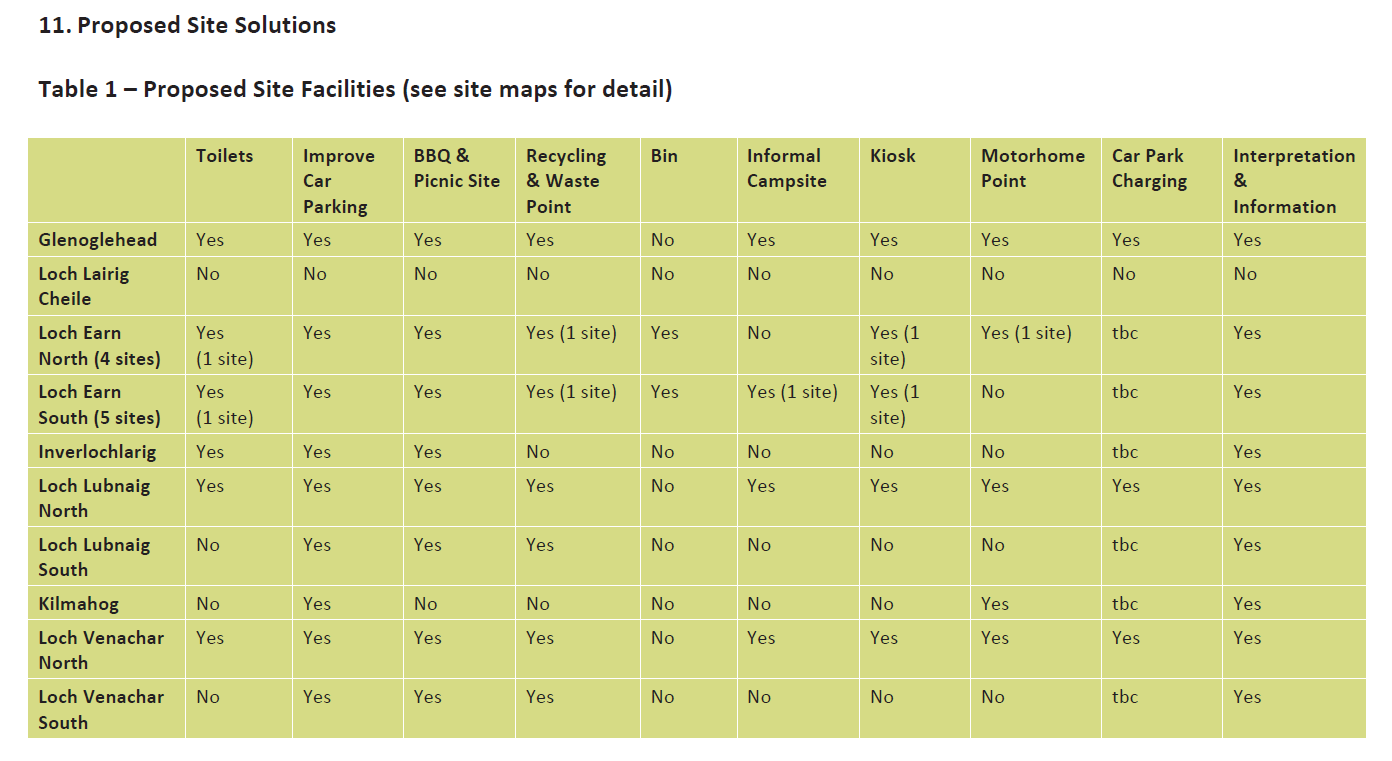
The reason that the LLTNPAis in this situation is because of its failing as a National Park, particularly over the last six years. In 2012, led by Grant Moir, now Chief Executive of the Cairngorms National Park Authority, the LLTNPA produced a plan to address some of the gaps in visitor infrastructure in the Trossachs, a first step towards developing such plans elsewhere. The plan was not perfect but it was far ahead of anything that had been done before and contained concrete proposals:
Out of the 6 new public toilets proposed for the Trossachs, only one, at Loch Lubnaig has been delivered. Had those toilets and other visitor facilities been in place, as intended, the LLTNPA would have been in a reasonable position to respond to a surge in visitors. Instead, Gordon Watson, now Chief Executive, abandoned the plan without any discussion at the Board. Board Members like Tory Councillor Martin Earl, now locally elected member for Callander, who had been involved in the plan never protested publicly. It’s his constituents that now face the brunt of that failure.
Instead of developing infrastructure for all visitors, the LLTNPA decided to target informal camping. It presented camping as the root of all visitor problems across the National Park and, after manipulating the public consultation , introduced the camping byelaws around all the most popular lochs. The byelaws were approved by Scottish Ministers on the basis that there would be a significant increase in camping provision. That too, has now been abandoned (see here) , with only the campsites at Loch Chon and Loch Achray, c50 places in all, to show for it. Over a thousand campsite places have been lost since the LLTNPA has been created. The consequences of the LLTNPA’s camping failures are now going to be exposed as never before.
What needs to be done?
The solutions to the immediate problems faced by the National Park are quite simple and could be applied across Scotland, but they need urgent action and investment now:
- Install portaloos in all the most popular visitor locations that lack public toilets and add portaloos to the places (like Luss) which lack sufficient capacity
- Create temporary campsites and places for campervans to stop off, as happens in the English National Parks. All that is needed is portaloos, some mobile washing facilities and a water supply. The Woodland Trust for example at Glen Finglas offered the use of a field for such purposes but this was rejected by “can’t do” National Park officials. The LLTNPA should be encouraging bids from farmers and other landowners to do this now.
- Double the number of permits available under the camping byelaws or, even better, suspend them for the rest of the summer and free up the Ranger Service to do useful things instead of checking permits
- Install traffic management systems to help people as they have done in the Lake District. There is no reason why we shouldn’t have an app to do this across Scotland
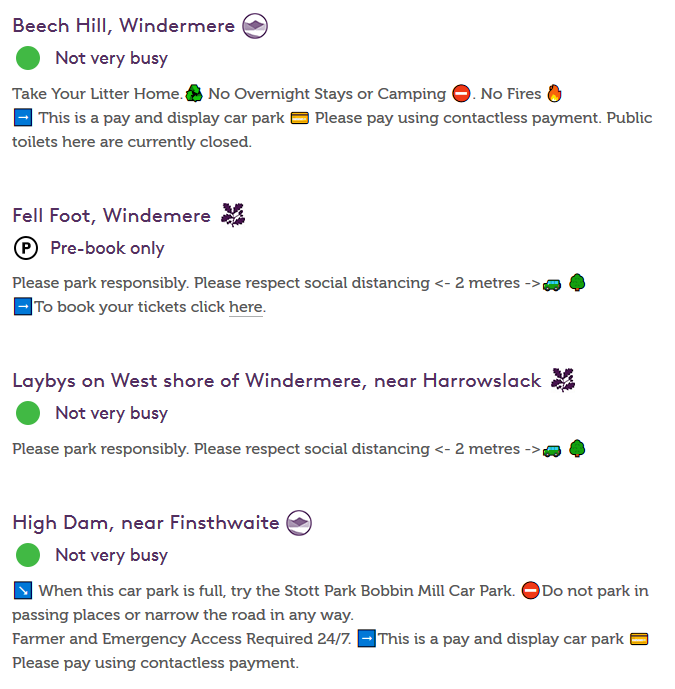
Extract from Lake District app last week
- Ensure LLTNPA Countryside Rangers are placed in visitor hotspots, like Balmaha and Luss, so they can assist the police to manage traffic, help people disperse into the countryside to stop overcrowding (and the risk of virus transmission) and nip any emerging problems in the bud. The Cairngorms National Park Authority has taken on seven new Rangers to help meet demand.
- Enhance the capacity of other Ranger and visitor management services. The National Trust for Scotland, which owns Ben Lomond, announced last week it was having to make 3/4 of it countryside Rangers redundant (see here for excellent statement from Scottish Countryside Rangers Association). Forest and Land Scotland, the largest landowner in the National Park, has been steadily cutting back on its visitor services. Such services will be needed as never before.
- Create additional temporary parking capacity in fields.
- Re-focus the large LLTNPA communications team on promoting alternative destinations and routes to the public, as is happening in the Lake District National Park, to help reduce traffic congestion and prevent overcrowding. There is plenty of space in the National Park and the rest of Scotland, unlike in England where there are no access rights and space is constrained, hence the crowded Dorset beaches. The challenge in Scotland is most people have only heard about popular places and they need to be helped to disperse through the countryside.
- Install litter bins in every layby and every popular stopping off point and empty them regularly. All the evidence shows that if litter bins are there, people will use them. Unfortunately the last LLTNPA Board Meeting was obsessed with how they could get people to take their litter home (and avoid all costs). It doesn’t work. Most people deposit litter in bins where they are available or will carry it out when away from the public road, it’s where there in no provision that the problems start. The Recycling facilities promised in the 5 Lochs Plan have never been delivered.
Paying for it all
Set aside the misuse of resources that has taken place over the last few years, even if the LLTNPA had achieved what it was set up to do, it would now be facing problems. In other Public Authorities the position is far worse, with Councils facing financial meltdown. Highland Council, the top rural tourist destination, now has a £96.9m deficit as a result of Covid-19 (see here). In that situation, there is no way they can invest in the facilities and resources that are needed to manage the visitor surge over the summer. The Scottish Government therefore needs to step in with an emergency funding package.
How much is required is not that difficult to work out:
- £1000 a week would pay for a cluster of 6 portaloos, at c£240 for the hire plus £100 per day to allow for staff to cover and clean as per infection prevention requirements. That comes to £16k for 4 months July-Oct. 200 such clusters across Scotland would cost £3.2m.
- Additional cleaning for 200? existing public toilets at £100 a day would cost £2.4m.
- 1000 additional litter bins at c£100 would cost £1m. Much of the cost of emptying them could be met if included in regular litter collection rounds but,
- Costs of additional collections in visitor hotspots and litter picking need to be estimated. £2m?
- Additional Rangers (and saving jobs of Rangers being made redundant) c£11k for four months. 200 Rangers would cost £2.2m
- Costs of temporary campsites should be met by campsite fees
This very rough estimate comes to a total additional cost of c£10m. Even if underestimated by 50%, £20 million is not a lot of money to prevent a countryside disaster. That would come to less than £4 a head for everyone living in Scotland.
In the longer term we need to invest far more than £20m in green infrastructure in the countryside, as Helen Todd, Campaigns and Policy Manager for Ramblers Scotland, has recently argued (see here). The summer surge in visitors is, for example, likely to put our footpath network under pressure as never before and expose the failings of our inadequate system of core paths (see here). Had the Scottish Government put a £2 a night tourist tax into place (see here), as happens in other countries, a £20m emergency investment, and much of the longer term investment could have paid for itself. In the absence of an equitable and fair mechanism for getting visitors to contribute to the costs of infrastructure in the countryside (and punitive car park charges are not the way to do this see here), the Scottish Government should stump up the cash now. Scotland’s countryside and people living in rural areas deserve no less.

Two points: Firstly, motorhomes can be entirely self contained so they cost nothing to support, although providing advice on where best to go and stay to avoid congestion clearly makes common sense, and if you you want to go further, providing stopping places for dealing with fresh/grey water and waste also make sense. And secondly, are we going to lay bets that, rather than responding proactively as you describe, instead the LLTNPA will take the same approach as Johnson and chums down South – and blame the visitors? Clearly this is a wasted opportunity to take a big step forward in delivering on its charter.
Hi Andrew, yes added to the investment should be public chemical disposal points across the countryside in Scotland. 20 such points on mainland Scotland at key points on the road network and one on each of the larger islands would be a good start. Nick
None of this (which is admittedly sensible) mentions the state of mind of people living in rural communities. The P&J carried a short article on Assynt and it should be clear that we are ‘no happy’ with the threatened influx, especially in view of what’s happening elsewhere. Facebook today is awash with angst against a Blue Discovery which littered and lit a fire at a Forestry Commission carpark at Inverlael to the south of Ullapool. There has been precious little engagement by noisy tourist interests with local communities as to ‘reopening’. As for campervans – they bring us nothing but trouble. And I don’t see them actually using the stopping points for waste disposal. It’s not in their nature.
‘it’s not in their nature’ … slightly prejudiced comment. I assume you’ve met all campervan owners to come up with this sweeping generalisation. Thought not. Just like any cross section of society, most will be ready to consider others and use facilities, if provided. A small minority will not. Basing your views on the extreme actions of the minority gets you nowhere.
Perhaps these communities should build walls against the deplorables
Hi Malcom, so are the people living in your local community who runs B and Bs, let out accommodation, work in restaurants or the shops that depend on tourism income to keep going the rest of the year not to be classed as tourism interests? The problem is a vocal minority in the Highlands has silenced all the people who depend on tourism for their income. And having spent a couple of days in Scourie campsite camping three years ago with friends who had a campervan and who had been eating out in local restaurants every second night I know your claim about campervans not contributing everything is not true.
Malcolm, although not visibly suffering from any “state of mind” I rather agree ! The thing that really annoys those who might offer self catering accommodation in remote communities is the way our interests have been sidelined and ignored till now. Right up until the moment at which a level of opening of self catering holiday premises is now an urgent imperative, and set to be sanctioned because the power to do this exists too . and yet….With careful cleaning , and 72 hours of delay between occupation periods -all now magically suggested- some of these remote premises could have been used part time for the past 6 weeks at least. The risk is identical now to then. Nothing has reduced the risk. Only now it is in the interests of the “wider public” (and more particularly vital for a few marginal politicians who find the most crucial demographic of their constituents are getting restive), holiday times for the masses are here.
To please these hordes the overarching “keep safe” message is no longer to be hammered home.
Everyone should see that NOTHING regarding this virus has actually changed since the earliest days of this pandemic. The NHS can be claimed to be better able to treat cases : properly equipped beds exist. Yet the potential for anyone from a congested home inner city area to carry the infection along with their “luggage” to remote areas that need never be infected, ever, is now somewhat greater than ever before. This is because the general public has grown familiar with boring repetitive mutterings about risks, very fed up and tired of being treated by Scotland’s ministers in a manner similar to how a parent might guard small children.
Just this week camper vans started to appear here in the west again. They have approached despite the ‘stay at home overnight’ edict. They come from further south. Here there are no grey water waste disposal facilities, all pubs hotels public conveniences, campsites and similar facilities are of course closed . Village Shopkeepers( after almost 16 weeks lockdown) do know exactly who is local. They will always refuse access for ‘in shop’ sales to strangers. Should abuse result, then even the safe option, of bringing a few listed items outside for them to pay for, will not be offered . It is notable that when one stranger in one van parked up along this road and was challenged about why he was there , it became quite clear where he planned to “go”. :- ” Och! there’s acres of hillside the other side of this fence.” ( FYI : This fence he planned to scale , (with or without shovel) remains ours. )
The not your park cabal I see have no choice but to abandon the camping bylaws the pathetic and questionable 300 spaces in the entire park will simply be overrun with people and majority will no nothing about the bylaws the police are going to be very busy everywhere and with riots and parties daily stabbings drinking the lochs will be the last thing on their minds if they do enforce the bylaws then the problems will be worsened farther up north where the people are still terrified to death
I am, as ever, bewildered by your pleading a special case for campervans/mobile homes. Your typical wee VW campervan, which drives like a car might be OK, but the gas guzzling monsters that permit holidays without any interaction with local culture or economy cause congestion and holdups, and many drivers cannot even negotiate A roads eg Berridale Braes (maybe fixed now?), let alone the many miles of single track. But as we do need more public toilets, maybe include a disposal point at each one. And litter bins are pointless. We have allowed a disposable culture to develop. Local authorities and national parks cannot deal with the the sheer volume of single use plastic and aluminium. More radical pro environment legislation is needed to reform packaging, and that will not happen soon. The new bins will be overflowing as soon as they are installed.
Hi Phil, you are right there are questions to raise about campervans and sustainability but what is worse in terms of impacts, taking a campervan round the Highlands or flying to say Turkey or Spain and staying in apartments that have wrecked some coastline? With a few basic facilities, neither campervans nor camping should leave a permanent trace. I personally don’t ever aspire to own a campervan but as long as campervanners are being scapegoated I will defend their right to travel round the Highlands. On litter, I agree that we need to reduce volumes of waste and that means the Scottish Government tackling the packaging industry. Unfortunately, all that happens at present is we get a worthy initiative, like the deposit return scheme, which takes years to get through the Scottish Parliament while the fundamental issues are not addressed. However, I disagree litter bins and recycling points are pointless, they are crucial and all the evidence shows they are used. I suggest you compare the roadside litter on the A9, where there are bins at every layby (will done Highland Council) to the A82 along Loch Lomond (Argyll and Bute Council) where there aren’t. Everywhere there are bins, you see them used. Nick
Presumably parkswatchscptland are in favour of the need to control excessive numbers of the public from congregating in outdoor areas and where there is a danger to public safety? https://www.stirling.gov.uk/news/2020/june-2020/finnich-glen-closed-to-the-public/
“Presumably parkswatchscptland are in favour of the need to control excessive numbers of the public from congregating in outdoor areas and where there is a danger to public safety? ”
I think this is a misuse of the law. The problem there is illegal parking. There are already road traffic laws to cover this. What next? Closing Glen Coe because it is steep and dangerous terrain. Stirling Council are ban happy. Closing roads first and now this.
As a matter of interest if access rights under the Land REform Act are suspended does that not mean it reverts to the pre 2003 situation. So no trespass law?
Yes, the application of a section 11 order to Glen Finnich does not prohibit public access. It simply means that the provisions of the 2003 Act, which are mainly concerned with facilitating public access to land and water, do not apply during the period that the order is in place. Members of the public can still take access, without risk of prosecution, but need to be aware of the risks involved due to the topographical nature of the terrain. Stirling Council were incorrect in stating that they were “formally prohibiting public access” to this area. Section 11 orders are primarily designed for events where temporary charging for access needs to take place on land where access rights apply. The Council should have used other legislation to deal with traffic and litter problems and simply erected notices in the Glen to warn of dangers due to the terrain. Furthermore they have also ignored the danger that their misuse of section 11 will encourage other landowners to pressurise Councils to use similar tactics to restrain public access. The real problem is lack of effective countryside management of the road system and its associated facilities by public bodies, not the rights and freedoms of the public to take access to Scotland’s land and water.
Gary, thanks for sharing and apols I thought I had posted this last night – although answers have now helped answer. “If this is about managing crowds as we come out of lockdown it contravenes Scottish Government advice that access rights were not affected by the Coronavirus Restrictions Regulations as Stirling Council has exempted the area from access rights. That would be a misuse our access legislation. The answer to crowds is NOT to ban all people – it simply shunts people elsewhere creating problems somewhere else – but to manage visitors. Hence why I argued for more Rangers in the Countryside, advice to visitors and an emergency funding package. Nick”
Lots of understandable concern and uncertainty about what is going to happen as visitors return to the Scottish countryside. However, the one thing that is certain is that people are going to visit, so it’s important that LLTNPA prepare for it and manage it. The Lake District perhaps provides some examples of what is likely to be experienced and hopefully LLTNPA have kept an eye on this. The car park monitoring system highlighted in Nick’s piece has provided good information for visitors and has looked like a good tool to indicate where resources in terms of rangers, police and volunteers are likely to be needed. One of the biggest factors is the weather. With LLTNP likely to receive a lot of new visitors, if the weather is good they will head in large numbers to the most obvious places with good access to water. This will also attract campers but so will other locations that are not within easy sight of places where people live. There is a theory that to some extent, because music festivals have all been cancelled youngsters are trying to recreate a festival type experience in the countryside. It seems that in the Lakes this has even included the odd van supplying drugs. Hopefully LLTNPA are aware of what to expect and have a strategy to deal with it.
A small additional thought, one with particular relevance to Scotland’s national parks and seaside areas across Britain these next weeks. Under the present regulations none of the usual summertime mass events are permitted. All the technical infrastructure required for safe running of these summer festival sites is currently sitting idle.( Portaloos, shower facilities, litter disposal systems, even the staff that maintain these HGV delivered containerised facilities, all are currently idle..probably sponsored by furlough if not already “cast” from their old employment. This ‘disconnect’ can so easily be taken advantage of. At present the Government is picking up the astronomical burden of providing subsidy to any companies needing support. Huge sums are being squandered on Furlough and state grants and individual aid. It will cost the tax payer nothing extra to instruct the firms that offer this service to go back to work. To provide at Public expense enlarged facilities for the general public on UK holidays to use. With access to containerised facilities , under some Government led scheme, there would be no need for consequential mess for local authorities to deal with later . There would be no reason why additional camping fields might not be be opened up at Government expense for caravans and camping, just for these few weeks of this summer holiday – if this period of Holiday really must be allowed to happen at all ? ( Of course by now it is probably far too late for any “committee work” to deliberate any of this. We have a son who runs a transportable event facilities outfit in NL. They have several million Euros worth of containerised seasonal event equipment, WC showers, freezers and kitchens etc and also a large transport fleet that might deliver it. All this specialist equipment and those who operate it – all sitting idle just now.)
Nick. Good evidence and fair comment in your post. They certainly point to needing a more strategic approach. The national tourism strategy launched just prior to lockdown had The vision – We will be the world leader in 21st century tourism. Without getting the basics right – toilets, litter, maintenance etc it is hard to see how that will be achieved. Countryside sites often fall between administrative responsibilities – roads, land managers, councils, communities, forestry, NPAs – no one is quite sure and action may be dictated by the volume of emails in the local MSP’s inbox.. We’ve brushed planning and maintenance under the carpet. I think your capital sum for Scotland is a bit light! For example toilets at a popular Skye site and car park cost £350k and rising. SEPA rightly required triple waste water treatment and extended pipework for discharge to larger river. Bore hole water supply – high aluminium and turbidity – needed more treatment to make it acceptable for use in the toilets. Electricity had to be laid into the site. Standard fittings were scrapped and replaced with touchless taps, foot operated flush and multiple hand sanitisers at 4/5 times the cost. Air dryers back to hand towels means more bins, cleaning and more storage of supplies. Cleaners with multiple PPE needs and welfare facilities on remote site further add to costs as does cleaner travel time multiplied by additional visits and 7 day opening. CCTV to prevent vandalism and theft which does occur at remote sites. Highland I think had around 100 public toilets and spent over £1million per annum – roughly £10k per loo. Many toilet buildings date from the 1970s and really need replacing. Chemical toilet treatment sites are around £30 – £50k dependent on location. Given the state of their finances, it is easy to see why Local Authorities look for cuts in what are non statutory responsibility. Car parks, litter and path maintenance at several pound/km per year are similarly pressured. Bridges on many of our LDRs and strategic mountain routes need replacement now or very soon and there is a legacy of damage from past storms not yet fixed. Maintenance lacks the glamour of innovation. It is mostly noticed in its absence. It is also more difficult for economists to measure as many of these items don’t deteriorate by the same amount each year. We should be more strategic and in the post Covid 19 Scottish Tourism Strategy amendments try to target a certain percentage of the income identified in your post for reinvestment in countryside assets and new management models to close the funding gap to truly make Scotland a 21st century leader in tourism. Canada invests about 3% of its GDP in ‘repair’, probably topping the list. And, don’t forget management and maintenance of these assets creates work in rural economies. ‘Trail head’ site management require a valuable skill set often missing – understanding peoples’ needs and behaviours and applying joined up thinking. Done well it can help sustain local economies. The Skye site mentioned previously supports 3 + FTEs and puts visitor cash back directly into other community assets like village halls. A local company 7 miles from the site are building the toilets. Parked cars no longer hinder ambulances and animal feed lorries. The bin wagon can get to local houses and hopefully, soon, it will only be the bears ( well Skye wildlife anyway) shitting in the adjacent woods!
Hi Duncan, this is very helpful but my costing was just for portaloos and emergency arrangements over the next few months, not for permanent toilets! You are quite right they are costly but also about the benefits. We do need a proper infrastructure programme and the sad thing is the LLTNPA was showing the way on that back in 2012 before they abandoned the 5 Lochs Plan. We need plans like that across Scotland! Nick
Real “outside the box” thinking needs to be developed a lot more across Scotland’s parks for the future . The need for permanent toilet buildings and other waste facilities year round at most sites with seasonal visitor loads is an investment debate to be had. Specialist contractors now have ability to bring and remove whole ” villages” of hygiene and waste equipment to festival sites. They used winch-on platform wagons, some with finger cranes, to position items. There is absolutely no reason why local authority infrastructure “fixed costs” should be any greater than the provision of hard standing on which a portable “facility” may be positioned in each season. Even water supply and waste management can be offsite, provided by bowsers and with mobile suction uplift from effluent tanks all of which can be contracted. Routine maintenance of these facilities would be done indoors at regional centres. Of course a National park appearance “spec” for the infrastructure of such containers can of course be very precise. The”boxes” have no need to look like industrial steel containers, but could be wood paneled,and similar to modern mobile homes, even have pitched roofs. Power systems can employ solar panels use battery powered inverters and LED lights. Once the portable concept is adopted, over each decade the National park standard design specs might move with the times, with no further groundwork costs, or reference to Sepa. This concept delivers a rolling net cost provision of service…little fixed capital cost. This would be a thinking ‘outside the Box’ concept, while in essence being all about easy to service and replace portable “boxes”.
Tom. I think the ‘plug and poo’ modular approach has much to commend it. Beaches in Brittany for example have concrete bases over tanks left in situ with superstructure dropped on top at the start of the season and regular pumping. I looked at the option of a fixed roofed structure with cubicles inserted underneath or removed according to seasonal demand. However, having discussed it with a few ‘portaloo’ suppliers logistical hurdles emerged around needing a fleet of tankers to pump out waste – often in remoter locations leading to reliance on a few centralised larger providers. Cleaning contracts similarly centralised with high costs and inability to respond to site demand fluctuations at high days and holidays. Festivals and construction site are more predictable and lucrative for contractors. Autonomous provision is possible but Scottish weather needs reliable sources of power and water and good all ability access.. Designs and spec can be adapted of course – self cleaning options may be possible. A pilot scheme to test some possibilities?
Three weeks down the line road closed at Ben Ann hohoho.locals furious at hillwalkers now hohoho do they(not your park) never learn if They can’t solve the problems they should be replaced with people who can (eg people with some common sense) and it should start from the top say goodbye Gordon hohoho can’t stop laughing made my day incompetence wins again